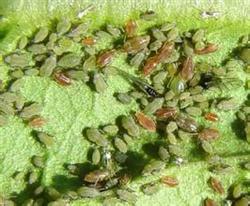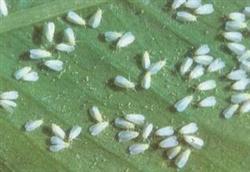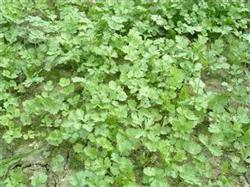Parsley peach aphid

Characteristic description and control methods of peach aphid Myzus persicae (Sulzer), belonging to Hemiptera (originally Homoptera; but now moved to Hemiptera), Aphididae. Alias greasy insect, tobacco aphid, peach aphid, oil man. Peach aphid is a broad-eating pest. There are about 74 families and 285 species of host plants. Peach aphid camp turned to host parasitic life cycle, in which winter host (primary host) plants are mainly pear, peach, plum, cherry and other Rosaceae fruit trees; summer host (secondary host) crops are mainly cabbage, cabbage, radish, mustard, brassica, turnip, sweet pepper, pepper, spinach, coriander and other crops. Peach aphid is not only the main pest of sweet pepper cultivation, but also the main transmission vector of many plant viruses. Peach aphids generally live in full cycle. In early spring, the overwintering eggs hatched into dry mothers, parthenogenetic parthenogenetic on the winter host, and reproduced for several generations. When the frost is broken, the winged viviparous female aphid is produced, which is harmful to the host plants such as Cruciferae and Solanaceae, and the wingless viviparous female aphid is propagated continuously, and the damage continues. It is not until late autumn when the summer host is aging, which is not conducive to the life of the peach aphid, that the winged female aphid migrates to the winter host and produces wingless female aphids and winged male aphids. After mating, they lay eggs on the winter host plants to survive the winter. The overwintering eggs have strong cold resistance and can survive the winter safely even in the northern alpine areas. Peach aphids can also be engaged in the incomplete cycle of parthenogenesis, for example, they can continue to breed on eggplant fruits and vegetables in the greenhouse in winter in the north. ① scavenges the insect plants. Clean the seedling site before sowing, pull out weeds and all kinds of residual plants; eradicate weeds around the field as soon as possible before planting, and burn them together with the fallen leaves in the field. ② strengthens field management to create a moist field microclimate that is not conducive to aphid breeding. ③ yellow board was used to trap aphids. Set a yellow plate around the sweet pepper field. That is, the plastic film covered with orange and yellow 66 cm square is wrapped and clamped inward from the top of the rectangular frame 66 cm long and 33 cm wide. Insert it around the sweet pepper field, 0.5 meters above the ground, 3 to 5 meters apart, and then apply oil on the unpainted outside. This can trap a large number of winged aphids. ④ silver film avoids aphids. Aphids are the main transmission vector of cucumber mosaic virus, and the border is covered with silver gray plastic film. ⑤ intercropping corn. Between two rows of sweet peppers with a width of 1 meter, corn was sown 6-7 days before planting according to the distance of 2 meters between plants, so that corn was higher than sweet pepper as soon as possible, so as to properly shade, cool down and prevent the transmission of aphids. ⑥ chemical control is the most effective measure to control aphids at present. Practice has proved that virus diseases can be effectively prevented as long as aphids are controlled. Therefore, it is necessary to try to eliminate the winged aphid before migrating to the sweet pepper, or to eliminate the wingless aphid in the sweet pepper field. When spraying, we should focus on the back of the blade. Spray 1500 times of 80% dichlorvos EC, or 1000 times of 40% dimethoate EC, or 1500 times of 50% malathion EC, or 1000 times of 50% diazinon EC, or 1500 times of 50% phoxim EC, or 1000 times of 50% fenitrothion EC, or 1000 times of 40% acephate EC, or 1000 times of 25% quinathion EC Or spray 1500 times 25% imidophos EC water, or spray 2000 times 50% parathion EC water, or spray 3000 times 2.5% deltamethrin EC water, or spray 4000 times 20% fenpropathrin EC water, or spray 5000 times 10% dicyanthrin EC water, or spray 4000 times 10% cypermethrin EC water, or spray more than 2500 times 10% cypermethrin EC water Or spray 1500 times 50% aphid pine EC water, or spray 4000 times 21% Juma mixture EC water, and so on.
- Prev

Why the growth of parsley seedlings is different
Characteristic description and control methods are also called small white moths. Adults and nymphs absorb plant juice, make leaves fade, turn yellow and wilt, secrete a lot of honeydew and pollute fruits and leaves. Native to southwestern North America, it was later introduced into Europe and is now widely distributed all over the world. In the north, greenhouses can give birth to more than 10 generations a year.
- Next

Management and Technical methods of coriander after the Beginning of Autumn
Characteristic description and control methods are often found in low-lying and moist land. After the incidence of coriander root system, the main root is yellowish brown or brown, soft rot, no or almost no fibrous root, the root system of the plant is broken as soon as it is pulled out by hand, the aboveground plant is short, and the leaves are withered and yellow. lose its commerciality. The prevention and cure method is to avoid as low as possible.
Related
- Where is it suitable to grow horseradish in China? it is expected to see the middle altitude horseradish in Alishan.
- How to prevent tomato virus disease reasonably? (Control methods included)
- Many people like to plant towel gourd on the balcony. What are the main points of this method and management?
- What crops can chili peppers be mixed with?
- Fertilization techniques and matters needing attention in Tomato
- What are the grafting techniques for peach seedlings in spring?
- Harm and control methods of root swelling disease of Chinese cabbage
- What are the pests of sweet potatoes? How to prevent and cure it?
- Symptoms, causes and Control methods of navel Rot in Tomato
- The cause of "Cucumber rotten bibcock" in Farmers' planting Cucumber and its Control Plan

